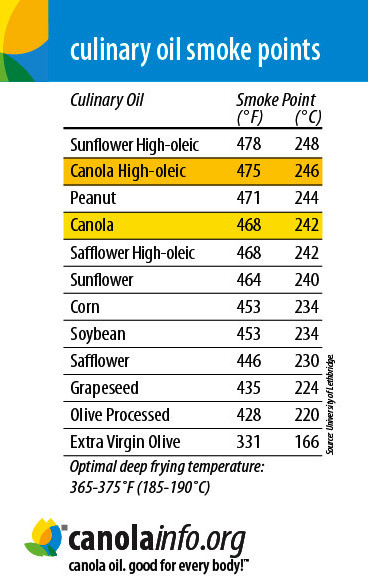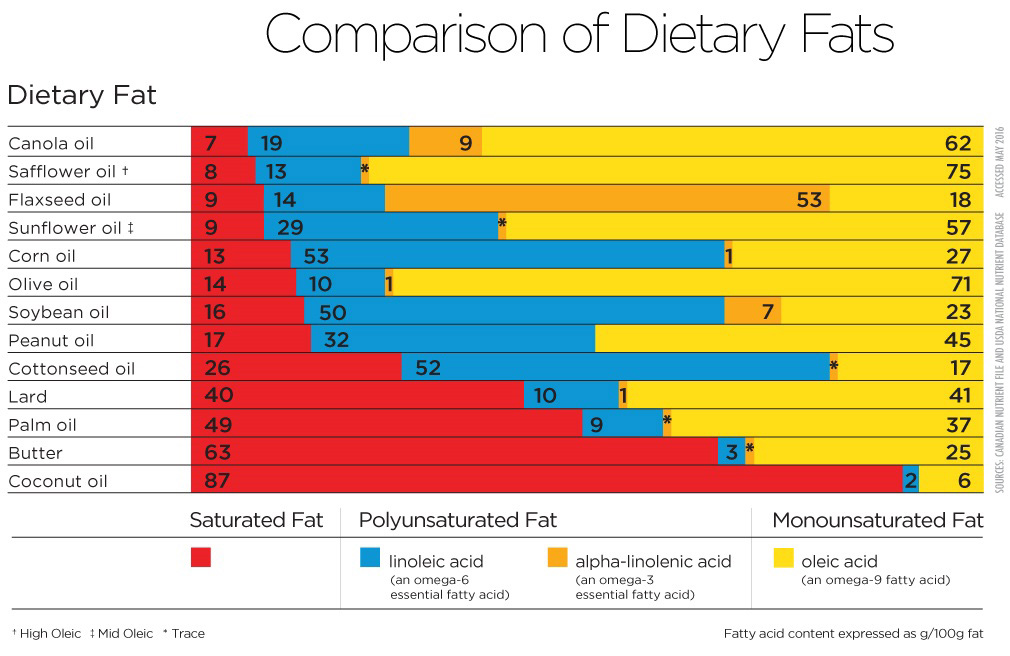 Ever wonder how canola oil stacks up against other edible oils? In honor of National Nutrition Month and March Madness, let’s size up the “competition,” starting with the weak challengers:
Ever wonder how canola oil stacks up against other edible oils? In honor of National Nutrition Month and March Madness, let’s size up the “competition,” starting with the weak challengers:
Coconut oil: Often erroneously touted for so-called health benefits, this high saturated fat (87%!) contender is solid at room temperature. That’s a good indication of what it will do to your arteries! This is why the U.S. government recommends cooking with liquid vegetable oils like canola in place of solid fats such as coconut oil, butter, shortening or lard.
Palm oil: This contender is also weighed down by saturated fat (49%). Because it’s cheap and plentiful, it is often used in food manufacturing. Be sure to check labels for ingredients and unhealthful nutrients as palm could leave a harmful print over time.
 Now for the quasi competitors:
Now for the quasi competitors:
Cottonseed, soybean and corn oils: While these are all liquid vegetable oils, they have double or more the saturated fat content of canola oil and far more omega-6 fat, which is too prevalent in the United States due to a huge supply of soybean oil. Experts say intake of omega-3 fat should be higher at the expense of omega-6. Canola oil is a good source of omega-3.
Peanut oil: This oil has less omega-6 fat than the three above but it has almost triple the saturated fat of canola oil. As well, it tastes like peanut which is undesirable in many food dishes. The only way that this oil really competes with canola oil is in heat tolerance based on smoke point (471 °F).
Sunflower oil: The sun isn’t smiling upon sunflowers in North America as their supply is quite low. It’s rare to find sunflower oil in grocery stores as what’s available is typically soaked up by food manufacturers due to its high heat tolerance (464 °F), especially in high-oleic (extra monounsaturated fat) form (478 °F). But this challenger’s omega-6 content (29%) is higher than ideal compared to omega-3.
Flaxseed oil: While an excellent source of omega-3 fat (53%!), this contestant cannot take the heat. In fact, it is solely for courtside (non-cooking) use.
This brings us to the best competitors:
Olive and safflower oils: Both are high in monounsaturated fat like canola oil. Safflower is on almost on par with canola in terms of saturated fat content and with its high-oleic version heat tolerance (468 °F), but it is uncommon and therefore, significantly more expensive. Extra virgin olive oil is even less affordable, does not perform well in heat and imparts a distinctive flavor to foods. So, you would need a bottle of both olive and safflower oils to meet all culinary needs.
Canola oil is the one and only that can be used in nearly all culinary applications and cuisines. It has a neutral taste, light texture, high heat tolerance (468 °F) and ideal fat profile. It has the least saturated fat (7%) and the most omega-3 fat of all common cooking oils. Now that’s a knock-out!

Angela Dansby is director of communications for the U.S. Canola Association.